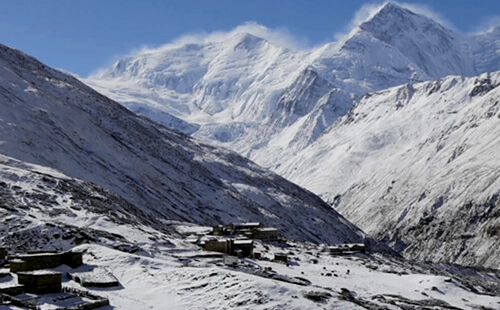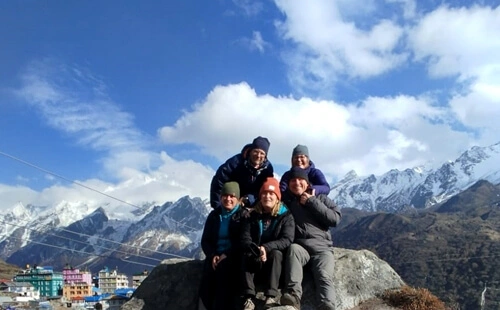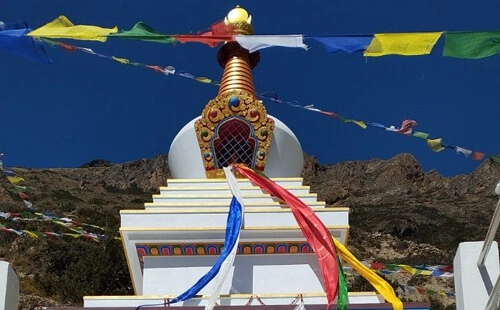The Annapurna region in Nepal, home to the legendary 10th-highest mountain in the world, Mount Annapurna I (8,091 m), is every adventurer's dream destination. The snow-covered mountain giants, thickly packed rhododendron forests, and rich cultures of several Nepalese ethnic communities, especially that of the Gurung and Thakali communities, charm trekkers, climbers, and nature lovers alike. Whether you are pursuing the full Annapurna Circuit Trek, the Annapurna Base Camp Trek, or short and scenic routes like the Ghorepani Poon Hill Trek, unforgettable memories are guaranteed.
However, often one question triggers: Do you need permits for the Annapurna Trek? Yes, you do. What are they, how much do they cost, and where do you get them? This blog covers everything you need to know about Annapurna Trek permits. The latest regulations for 2025 and 2026 are here, so the navigation process is smoother, and you have the right documents for your adventure. To make it simple, obtaining permits for a trek to Annapurna supports the Nepalese government for conservation of the fragile Himalayan ecosystem and culture, where you traverse.
Do you need permits for the Annapurna Trek? Know the Right Permits for your trip!
Table of Contents
Why do you need permits for the Annapurna Trek?
The Annapurna Trekking region rivals the infamous Everest hiking routes, taking you deeper into the land of the 10th highest mountain in the world within Nepal’s largest conservation area, the Annapurna Conservation Area. Hence, individuals entering the area for an outdoor adventure experience must obtain the associated Annapurna permit.
The permits by the Nepal government are to regulate safety and conservation in tourism. The Annapurna Trek Permit fees directly contribute to maintaining trails, aid in community development, and support the Himalayan environment. In addition, it is also to keep tourist records and provide rescue operations in need.
Checked at various checkpoints on a daily basis, without the proper permits for the trek to Annapurna, visitors risk fines, being turned back, chances of going off track, and also missing out on the full trekking experience. Therefore, before your official departure, Nepal trekking permits are to be secured first.
What permit do you need for trekking in Annapurna?
For most treks in the Annapurna region, such as the Poon Hill Trek, Mardi Himal Trek, Khopra Danda Trek, and Annapurna Panchase Trek, there are specifically two permits. The Annapurna Base Camp Trek permit and the Annapurna Circuit Trek permit are also the same unless and until trekkers decide to extend their Himalayan venture to other or combined trekking regions like the Upper Mustang Valley Trek and the Nar Phu Valley Trek.
Otherwise, the main permits for trekking in Annapurna are the Annapurna Conservation Area Permit (ACAP) and the Trekkers’ Information Management System (TIMS) card. ACAP gives trekkers access to the Annapurna Conservation Area with several iconic trekking routes to embark on, each with its own set of challenges and rewards, while a TIMS card is a standard Nepal trekking permit essential for trekking in almost all the Himalayan trekking regions, including Langtang Valley.
Where to get Permits for the Annapurna Trek?
Generally, trekkers in Nepal can obtain permits for the Annapurna trek from Kathmandu and Pokhara. Both the ACAP and TIMS cards are available in the Nepal Tourism Board (NTB) and Trekking Agencies’ Association of Nepal (TAAN) offices. Nepal trekking permits online, including the Annapurna Trek permit online, are limited to registered trekking agencies of Nepal.
This means individuals are issued permits with in-person applications through the licensed trekking company or by visiting NTB and TAAN offices in Kathmandu and Pokhara. In Kathmandu, the NTB office is in Bhrikutimandap, and in Pokhara, it is at Damside, while the TAAN office at the present time is only in Kathmandu and is in Maligaun.
Who needs to get Nepal trekking permits?
All tourists planning to trek to the Himalayan regions of Nepal, like Everest, Langtang, Kanchenjunga, Manaslu, and Mustang, including Annapurna, are required to first get permits dedicated to a certain designation. While locals are exceptional, except for highly restricted areas like Kanchenjunga, Upper Dolpo, and Upper Mustang, all foreigners, including SAARC nationals, must have Nepal trekking permits.
Traveling in a group with tour operators or embarking on a family, private, or solo trek with a professional guide, trekking without proper permits is considered illegal throughout the country. Therefore, wherever you are planning to spend your holidays in the Nepalese Himalayan trekking region, including the Annapurna treks, permits are mandatory.
Contact us now; our service includes arranging local guides for you who manage all the essential trekking logistics, including permits for the Annapurna Trek.
How long are the Permits for trekking in Annapurna valid?
The Annapurna Conservation Area Permit (ACAP) and the Trekkers’ Information Management System (TIMS) card are the required permits for the Annapurna trek. Lasting for the start and end of your Himalayan expedition, the entire Annapurna Trek itinerary, regardless of the number of days, the permits are for a single entry, which means if you are entering the region more than once to begin another journey, you will need to get permits each time.
These permits are not extendable, transferable, or refundable. If you change your mind midway and are thinking of transferring it to fellow travelers, it is not allowed. Therefore, to save time, money, and energy, booking your Annapurna trip with trusted treks and travel agencies such as Adventure Himalayan Travels and Treks, with more than two decades of experience, is strongly advised.
Must you get restricted area permits to trek to Annapurna?
No, as most of the trekking routes in the Annapurna region are within the Annapurna Conservation Area, which further is not part of any restricted areas of Nepal, trekkers do not need a restricted area permit (RAP) to trek to the Annapurna Himalayas. The standard two permits are enough to complete both the popular and off-the-beaten-path treks inside the Annapurna Trekking Region, including the Annapurna Base Camp Trek, Annapurna Circuit Trek, Mardi Himal Trek, and Ghorepani Hill Trek.
But if your visit involves making your way through restricted areas designated for their proximity to the international border, sensitive culture, and the Himalayan ecosystem, trekkers are required to obtain a Restricted Area Permit (RAP). These permits are mandatory for visiting Upper Mustang, Upper Dolpo, Kanchenjunga, and Tsum Valley. Otherwise, restricted area permits are not necessary for all standard Annapurna trekking routes.
What documents are required for the Annapurna permit?
To apply for Annapurna Trekking Permits, trekkers will need a passport with at least six months of validity and a Nepal visa. Other than these two passport-sized photos, a brief trekking itinerary, travel insurance details, emergency contact information, and, if with trekking agencies, information related to it are necessary documents required for the Annapurna permit. Digital photos are also often accepted, but the best practice is to have physical copies.
Traveling alone without a local guide has been banned in Nepal since April 1st, 2023. On hiring reliable tour operators or trek organizers like Adventure Himalayan Travel and Treks, we handle all permit formalities. Our comprehensive Annapurna Trekking Package also covers you from the Annapurna Trek Permit fee, including the Annapurna Base Camp Trek Permit and the Annapurna Circuit Trek. A memorable and hassle-free trekking experience is our commitment.
When should you apply for Annapurna Trekking Permits?
Whether you are already in Nepal or not, applying for Trekking permits to Annapurna ahead of time is to avoid delays and ensure a fixed departure of the trip. While you may apply a few days before your trek officially begins from the Nepal Tourism Board (NTB) offices in Kathmandu and Pokhara, especially when you are already in Nepal, during peak seasons, it is recommended to apply at least 5-7 weeks before.
Due to higher demands, it may take longer to secure Permits for trek to Annapurna in spring and autumn, regarded as the prime time for high-altitude trekking and climbing in Nepal, including for Himalayan treks to Annapurna. There are also several authorized trekking agencies like Adventure Himalayan Travels and Treks to manage it for you at some fees that are often part of the service.
While in off-peak season, Annapurna permits can be processed faster; licensed trekking companies apply for permits several weeks before, so all you are left to do is make the best out of the journey without having to go through the hectic Annapurna Trek permit procedure. As soon as your itinerary is finalized, to avoid administrative issues from occurring and delaying your trip, we arrange it even before your trekking journey begins.
Is hiring a guide mandatory during the trek to Annapurna? Why?
Yes, Nepal banned backpackers and free individual trekkers (FITs) in its trekking regions within the national park, conservation area, and restricted lands, including in the Annapurna trekking region, effective April 1st, 2023. While solo trekking is still available, now it is not traveling with a group; instead, it is you and your licensed guide. This is to enhance safety, promote responsible tourism practices, and support local employment.
Whether you are experienced or a novice, young or old, or on a budgeted or luxury Annapurna trek, hiring a government-registered guide is a must. Knowledgeable of the Himalayan terrain, culture, and major highlights of each specific trekking destination trekkers are embarking on, including Annapurna trekking trails, the guide leads the way, navigates even the tough parts for you, and also provides immediate assistance in emergencies.
Licensed local guides, such as those from Adventure Himalayan Travels and Treks, are capable of managing permits for a trek to Annapurna as they are handling essential Nepal trekking logistics like meals, lodging, and transportation. Even in the peak trekking season, requiring booking in advance, their local connection can get you the best offers and choices on the way.
How much do Annapurna Trek permits cost?
The Annapurna permit cost can vary based on nationality and the type of trek one is committing to: solo, group, family, or private. The standard rates for tourists across the globe trekking to the Annapurna Himalayas are NPR 3,000 (around USD 25-30) for the Annapurna Conservation Area Permit (ACAP) and NPR 2,000 (around USD 15-20) for the Trekkers’ Information Management System (TIMS) card.
Trekkers from SAARC (South Asian Association for Regional Cooperation) nations such as India, Bhutan, and Bangladesh are liable to significant discounts of almost 50 percent. Children below 10 years old and Nepali citizens do not need Permits for the Annapurna Trek. These permits are issued for guided treks; hire our experienced Sherpa guide at Adventure Himalayan Travels and Treks.
While the Annapurna Nepal Trekking Permit fee is generally the same throughout the year and is priced as briefed above, it may change with the Nepal government's official revision of the fee schedule through the Nepal Tourism Board National Trust for Nature Conservation. It is a matter of change; hence, for more up-to-date Annapurna Trekking Permits and cost, stay in touch with the related authorities and contact us now!
Can you go for the Annapurna trek without the permits?
No, trekking without permits in Nepal is considered illegal, especially when you are traversing through one of the conservation areas of the country, the Annapurna Conservation Area, which is to conserve the unique Himalayan ecosystem and wide range of flora and fauna in their natural habitat, including the unique culture of locals side by side. If trekkers are found without permits, the implications can be quite harsh: fines, being turned back at different checkpoints, and worse, legal actions against them.
Not obtaining the Annapurna permits for trekking is a violation of Nepalese laws and contrary to the local interests and conservation efforts. In case of loss of permits, it is to be reported to the nearest checkpoint or authority to seek guidance and possibly obtain a duplicate permit. To conclude, permits are mandatory for trekkers to legally access the Annapurna Trekking Region and its several hiking routes, including in the years 2025 and 2026. Get permits, travel responsibly, and travel safely.
Conclusion
Having the right Annapurna Trek Permits ensures trekkers a safe, legal, and enjoyable journey through the heart of the majestic 10th-tallest mountain in the world, Mount Annapurna (8,091 m), and its ranges. Have a clear itinerary. Secure your permits in advance. Bring Nepalese cash. Make several copies of your documents and put them in a waterproof bag for checkpoints. Support Nepal to conserve its natural and cultural treasures with trekking permits to Annapurna and have a smoother journey! Book with Adventure Himalayan Travels and Treks now!




